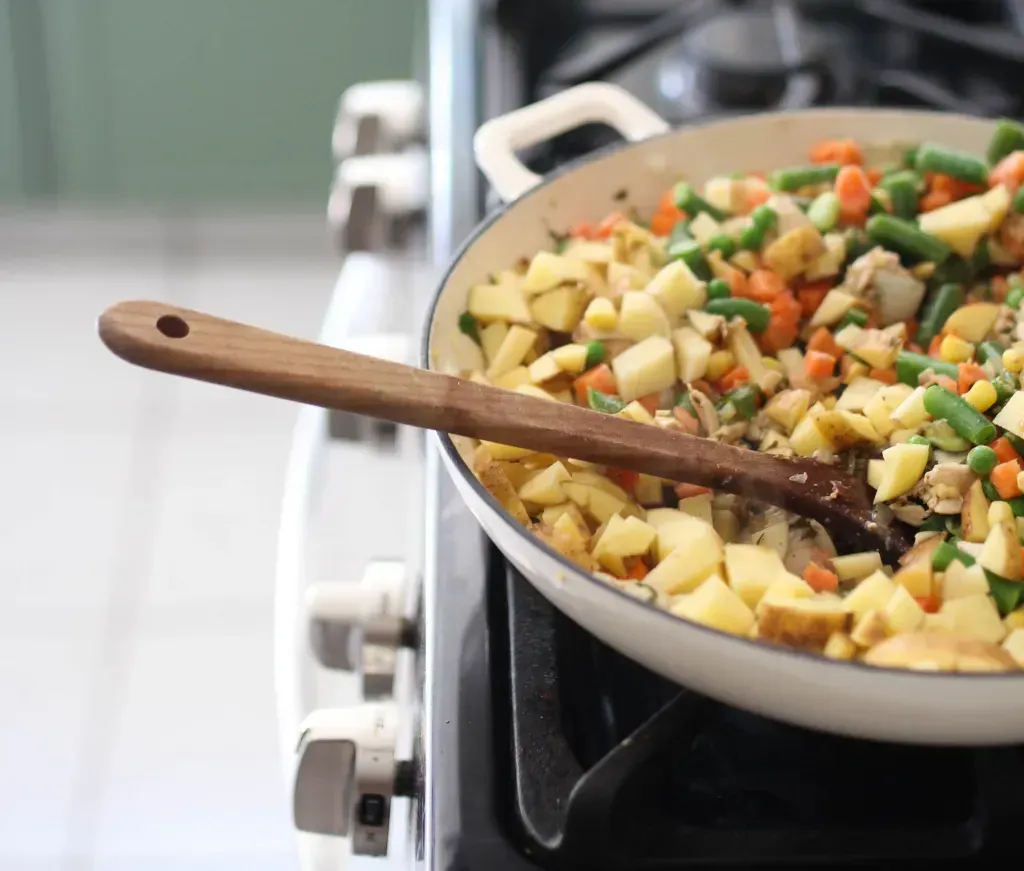Chicken Pot Pie
Creamy, comforting and filling is the perfect description for this classic chicken pot pie. Packed with flavour & loads of veggies, it tastes so much better than any freezer or store-bought pot pie. Having Wholesome pie crusts and a pack of mixed veg on hand in your freezer makes this an easy meal you can whip together anyway of the week!
INGREDIENTS
- Wholly Wholesome gluten free pie shells (comes in a pk of two)
- organic, free range chicken, 1-2 breasts or a handful of tenders (we used chicken from Yorkshire Valley Farms)
- 2 cups mixed organic veggies
- 1 cup chopped organic potatoes (feel free to leave the skins on)
- 1/2 chopped onion
- 4 cloves garlic
- Couple sprigs of fresh rosemary, thyme, sage or 1 tsp of each dried
- 1 tsp herbamare
- 1/2-1 tsp black pepper
- 2 tbsp flour
- 1 cup chicken broth
- 1/2 cup cream

DIRECTIONS:
- In a skillet, heat up some olive oil and add your chopped onion and minced garlic to sauté.
- Next mix in your herbs, cracked pepper and herbamare.
- Then add your chicken and sauté till cooked through and cut into bit sized pieces.
- Add your mixed vegetables and diced potatoes and stir for 2-3 min.
- Sprinkle flour over vegetables and chicken mix and stir to coat. Pour in your chicken broth and cream and stir till a thick sauce forms.
- Pour mix into uncooked pie shell and cover with second pie shell. Gentle lift second pie shells off to create a lid to the pot pie and cut three slits into top of shell to allow ventilation and pinch the edge of the pie with a fork to seal the two pie shells together.
- Bake in oven at 350 for 35-45 min until golden brown.


Packed with vitamins A and C, fibre, and antioxidants, autumn squashes are a true gift from nature that can help support immune health, glowing skin, and sustainable nutrition through the colder months. From the sweet nuttiness of acorn and butternut to the rich, velvety texture of kabocha and spaghetti squashes, each variety offers its own unique flavour profile and nutritional benefits. Here are 4 delicious takes on squash: Roasted Acorn Squash, Traditional Kabocha Croquettes, Butternut Squash Pizza, and Stuffed Spaghetti Squash. Also be sure to check out more of our Butternut Squash Soup and Stuffed Acorn Squash recipes.

Don't get us wrong, Pumpkin Spiced Lattes are delicious. But, there are tons of other fall flavours that get forgotten this time of year. And as Canadians, we simply cannot let maple syrup get overlooked! So, we're sharing a festive fall Salted Maple Cinnamon Latte recipe that you can enjoy both hot and iced - die-hard iced coffee drinkers no matter the season, we see you! Maple syrup and cinnamon are both sources of antioxidants that help your body fight inflammation. Maple syrup also contains vitamins, minerals, and amino acids! Enjoy the benefits of these delicious ingredients in this simple and cozy drink!

Soup season is upon us! As the days grow colder, there's few things as comforting as a warm bowl of soup. We're sharing two of our favourite nourishing classics - Cream of Broccoli and Cream of Carrot. Made with super simple, whole food ingredients, these recipes are easy to prepare and packed with nourishing veggies and warming spices. Grab your pot and let's get simmering!







